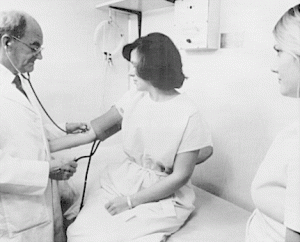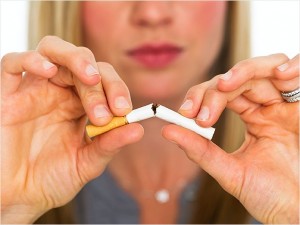 This month marks the 41st anniversary of Roe v. Wade, the pivotal case where the United States Supreme Court legalized abortion. Many see this decision as both a political and religious issue, while others view this as the right for women to make private medical decisions without the interference of politics. Regardless of how you view abortion, it’s important to recognize the evolution of women’s health in America to see how far we’ve come in this field.
This month marks the 41st anniversary of Roe v. Wade, the pivotal case where the United States Supreme Court legalized abortion. Many see this decision as both a political and religious issue, while others view this as the right for women to make private medical decisions without the interference of politics. Regardless of how you view abortion, it’s important to recognize the evolution of women’s health in America to see how far we’ve come in this field.
Here is a brief timeline outlining notable events in women’s health in the United States.
1800: This year, every American woman had an average of seven children over her lifespan. The birthrate reached an all-time high of 55 births per thousand residents—today the rate is 13 births per thousand.
1849: Elizabeth Blackwell ranked first in her class at New York’s Geneva Medical College, making her our country’s first female doctor. Battling sexism and prejudice, Blackwell founded a small clinic that eventually grew into the New York Infirmary for Women and Children and even opened the Women’s Medical College in 1868 to train more female physicians.
1896: The first commercial menstrual care product in America came on the market from a “little known” company called Johnson & Johnson. Unfortunately, this model was a commercial failure and it wasn't until 1921, with the invention of Kotex, that menstrual care products found their market success.
1916: Margaret Sanger opened America’s first birth control clinic in Brooklyn, New York. Later, in 1921, she founded the American Birth Control League, which was eventually called Planned Parenthood.
1931: Robert Tilden Frank, a New York gynecologist, became the first researcher to give medical credence to premenstrual syndrome.
1960: The FDA approved the sale of the birth control pill, the first oral contraceptive manufactured by Searle.
1969: The low-radiation mammogram was invented, minimizing the risk of high doses of radiation on earlier models.
1970: The publishing of Our Bodies, Ourselves revolutionized views about the female body and sexuality. It is a book written by women, for women, and has sold more than 4 million copies since its publication.
1973: Roe v. Wade decision made by the United States Supreme Court.
2006: The FDA approved the emergency contraceptive pill Plan B for prescription use. It is now sold over-the-counter for women 18 and older.
2007: Dr. Teresa Woodruff edits the first book on oncofertility, a new field that studies how to preserve fertility in patients whose fertility has been compromised due to cancer treatment.
Of course we know that women's health extends well beyond these notable triumphs, and we're looking forward to a future where innovative advances in women's health continue to become more frequent and groundbreaking.
Source: Everyday Health
 The first ever Recommendations for Diagnosing TMD have been published with support from NIH. Despite a prevalence rate of 2:1 women to men, there was no mention of the sex differences for TMD in the abstract, NIH press release or accompanying editorial. This continues to frustrate the women's health research community who are actively advocating for more sex based research. This latest announcement indicates we must continue to be vigilant and work with funders and journals to ensure that sex differences become part of the research equation. Temporomandibular disorders (TMD) occur as a result of problems with the jaw, jaw joint and surrounding facial muscles that control chewing and moving the jaw. These disorders are often incorrectly called TMJ, which stands for temporomandibular joint.
The first ever Recommendations for Diagnosing TMD have been published with support from NIH. Despite a prevalence rate of 2:1 women to men, there was no mention of the sex differences for TMD in the abstract, NIH press release or accompanying editorial. This continues to frustrate the women's health research community who are actively advocating for more sex based research. This latest announcement indicates we must continue to be vigilant and work with funders and journals to ensure that sex differences become part of the research equation. Temporomandibular disorders (TMD) occur as a result of problems with the jaw, jaw joint and surrounding facial muscles that control chewing and moving the jaw. These disorders are often incorrectly called TMJ, which stands for temporomandibular joint.
 Many people don’t realize that the symptoms of attention deficit hyperactivity disorder (ADHD) can continue into adulthood as a form of adult ADHD. Adult ADHD can only result from a pre-existing diagnosis of childhood ADHD—meaning, one is only susceptible to adult ADHD if they suffered from this disorder as a child. Roughly 3-10% of school-aged children are afflicted by ADHD, and 60% of these children will continue to have symptoms when they’re adults. Symptoms manifest themselves into forgetfulness, excessive daydreaming, constant fidgeting, and the inability to sit still. These symptoms are more subtle in adults and adult ADHD is, therefore, more difficult to diagnose.
Many people don’t realize that the symptoms of attention deficit hyperactivity disorder (ADHD) can continue into adulthood as a form of adult ADHD. Adult ADHD can only result from a pre-existing diagnosis of childhood ADHD—meaning, one is only susceptible to adult ADHD if they suffered from this disorder as a child. Roughly 3-10% of school-aged children are afflicted by ADHD, and 60% of these children will continue to have symptoms when they’re adults. Symptoms manifest themselves into forgetfulness, excessive daydreaming, constant fidgeting, and the inability to sit still. These symptoms are more subtle in adults and adult ADHD is, therefore, more difficult to diagnose. This month marks the 41st anniversary of Roe v. Wade, the pivotal case where the United States Supreme Court legalized abortion. Many see this decision as both a political and religious issue, while others view this as the right for women to make private medical decisions without the interference of politics. Regardless of how you view abortion, it’s important to recognize the evolution of women’s health in America to see how far we’ve come in this field.
This month marks the 41st anniversary of Roe v. Wade, the pivotal case where the United States Supreme Court legalized abortion. Many see this decision as both a political and religious issue, while others view this as the right for women to make private medical decisions without the interference of politics. Regardless of how you view abortion, it’s important to recognize the evolution of women’s health in America to see how far we’ve come in this field. Men and Women are physiologically different, and it is essential to ensure adequate participation of both sexes in research studies in order to determine sex-based differences in disease presentation, prevalence, and treatment. A press release from Mary Ann Liebert, Inc. Publishers revealed a study that tested the participation rate of women in post-approval studies mandated by the Food and Drug Administration (FDA). Out of their sample size, researchers found that only 14% of studies “included a multivariate analysis that included sex as a covariate” and a meager 4% “included a subgroup analysis for female participants.” These shocking results mean that women are not getting adequate attention in clinical trials, which may result in harmful drug or device reactions in women.
Men and Women are physiologically different, and it is essential to ensure adequate participation of both sexes in research studies in order to determine sex-based differences in disease presentation, prevalence, and treatment. A press release from Mary Ann Liebert, Inc. Publishers revealed a study that tested the participation rate of women in post-approval studies mandated by the Food and Drug Administration (FDA). Out of their sample size, researchers found that only 14% of studies “included a multivariate analysis that included sex as a covariate” and a meager 4% “included a subgroup analysis for female participants.” These shocking results mean that women are not getting adequate attention in clinical trials, which may result in harmful drug or device reactions in women. Everyone wrinkles at the same rate and there’s not really much we can do to prevent it, right? Wrong. There are certain habits that can help you avoid premature wrinkles, making your skin look younger (and healthier) longer. Tanning is one of the leading causes of premature wrinkles. When you go tanning, ultraviolet rays are penetrating deep layers of the skin, weakening the skin’s support structure. Wearing lotion with SPF 15 or higher will help protect your skin, and should become part of your routine. Smoking also accelerates the skin’s aging process, and early wrinkling has been found in smokers as young as 20! The smoke from tobacco also turns the skin an unhealthy color and texture, so the best thing you can do for your skin and your body is to quit smoking!
Everyone wrinkles at the same rate and there’s not really much we can do to prevent it, right? Wrong. There are certain habits that can help you avoid premature wrinkles, making your skin look younger (and healthier) longer. Tanning is one of the leading causes of premature wrinkles. When you go tanning, ultraviolet rays are penetrating deep layers of the skin, weakening the skin’s support structure. Wearing lotion with SPF 15 or higher will help protect your skin, and should become part of your routine. Smoking also accelerates the skin’s aging process, and early wrinkling has been found in smokers as young as 20! The smoke from tobacco also turns the skin an unhealthy color and texture, so the best thing you can do for your skin and your body is to quit smoking! Every year there are roughly 137 million births globally. Of these, about 10% may result in serious complications. Tragically, approximately 5.6 million babies are stillborn or pass away soon after, and around 260,000 women pass away every year in childbirth. These situations often occur in underdeveloped countries or rural areas where women do not have access to hospitals or procedures such as a cesarean section when undergoing an obstructed or prolonged labor. Currently, when situations like this arise, options to extract the baby include using forceps or a vacuum extractor, which can twist the baby’s spine, crush its head, or cause hemorrhaging. Despite these statistics and outdated technologies, there has been little to no technological advancement in this area for years.
Every year there are roughly 137 million births globally. Of these, about 10% may result in serious complications. Tragically, approximately 5.6 million babies are stillborn or pass away soon after, and around 260,000 women pass away every year in childbirth. These situations often occur in underdeveloped countries or rural areas where women do not have access to hospitals or procedures such as a cesarean section when undergoing an obstructed or prolonged labor. Currently, when situations like this arise, options to extract the baby include using forceps or a vacuum extractor, which can twist the baby’s spine, crush its head, or cause hemorrhaging. Despite these statistics and outdated technologies, there has been little to no technological advancement in this area for years. Swedish doctors are attempting an innovative surgery to give womb-less women the opportunity to give birth to their own children. Nine women in Sweden have received womb transplants and doctors intend to help these women (through in-vitro fertilization) become pregnant and carry their own children. Each of the nine patients was either born without a uterus or had it removed due to cervical cancer. This is the fist major experiment to test the possibility of live, biological births in womb transplant patients.
Swedish doctors are attempting an innovative surgery to give womb-less women the opportunity to give birth to their own children. Nine women in Sweden have received womb transplants and doctors intend to help these women (through in-vitro fertilization) become pregnant and carry their own children. Each of the nine patients was either born without a uterus or had it removed due to cervical cancer. This is the fist major experiment to test the possibility of live, biological births in womb transplant patients. In the January of 1964, the Surgeon General made its first report linking cigarette smoking to lung cancer. Yesterday, the CDC announced a new triumph in the war against lung cancer by announcing that the rate of new lung cancer cases have decreased among men and women in the United States since 2005. Lung cancer incidence rates decreased 2.6% per year among men, and 1.1% per year among women. While, generally, this is a significant victory, the differing rates between men and women are troubling.
In the January of 1964, the Surgeon General made its first report linking cigarette smoking to lung cancer. Yesterday, the CDC announced a new triumph in the war against lung cancer by announcing that the rate of new lung cancer cases have decreased among men and women in the United States since 2005. Lung cancer incidence rates decreased 2.6% per year among men, and 1.1% per year among women. While, generally, this is a significant victory, the differing rates between men and women are troubling. At this point, Chicagoans are celebrating the end of the Polar Vortex, which caused temperatures as low as -40 degrees (with the wind-chill) in our windy city. But, extreme shifts in temperatures can mean extreme health concerns to be aware of. Respiratory problems, the rise of the common cold, frostbite, and hypothermia are just some health problems that can arise in extreme weather changes.
At this point, Chicagoans are celebrating the end of the Polar Vortex, which caused temperatures as low as -40 degrees (with the wind-chill) in our windy city. But, extreme shifts in temperatures can mean extreme health concerns to be aware of. Respiratory problems, the rise of the common cold, frostbite, and hypothermia are just some health problems that can arise in extreme weather changes. From perimenopause through postmenopause, the most common symptoms include irregular menstruation, hot flashes, and night sweats. Every woman will experience these menopausal symptoms differently. However, research shows that women who survive cancer, in particular, have more frequent, severe, and bothersome hot flashes than other women with menopausal symptoms. Women who survive cancer also report better emotional and social well-being, compared to women without cancer.
From perimenopause through postmenopause, the most common symptoms include irregular menstruation, hot flashes, and night sweats. Every woman will experience these menopausal symptoms differently. However, research shows that women who survive cancer, in particular, have more frequent, severe, and bothersome hot flashes than other women with menopausal symptoms. Women who survive cancer also report better emotional and social well-being, compared to women without cancer.